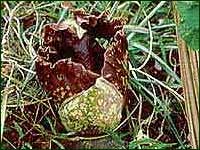Elephant-Foot Yam
Early European explores returned from Southeast Asia with fantastic stories about a group of bizarre plants they had seen—elephant-foot yams. Over time, these stories became so exaggerated that they more resembled science fiction than hard science. The solitary giant blossoms of the elephant-foot yam emit a stench like that of rotting meat, which is noticeable even from ten meters away. The explores claimed that the smell was so overpowering that anyone coming too close risked passing out. Nevertheless, we have studied them and have remained standing.
One species of these bizarre plants grows in the Philippine and is locally know as pungapong (Amorphophallus campanulatus). It belongs to the jack-in-the-pulpit and skunk cabbage family. A perennial herb with very large underground tuber 30 centimeters or more in diameter, the pungapong weighs about 25 kilograms. Its tuber sends out a single, very large leaf on a three-meter-high, purple-mottled stalk. A multicolored flower head later emerges with a thick, bell-shaped, ruffled cape (30 centimeters long, 45 centimeters across). Inside this giant flower head is a globular, cone-shaped flower stalk that is spongy, slightly wrinkled, and purple, and to which hundreds of minute flowers are attached. Male flowers are situated above female flowers, and beetles attracted by the smell of carrion transfer pollen from the males to the females. The flower stalk is warmer than the rest of the plant, a fact that is thoughtto be central in volatilizing and dispersing the odors.
After fertilization, in place of the female flowers, the stalk will bear numerous small fruits, green at first then turning yellow to red when ripe. Researchers have noticed that the stalk elongates slightly, presumably to display the ripe, juicy berries to birds that will eat them and disperse their seeds over great distances.
Original URL: http://archive.fieldmuseum.org/vanishing_treasures/V_EFYam.htm

